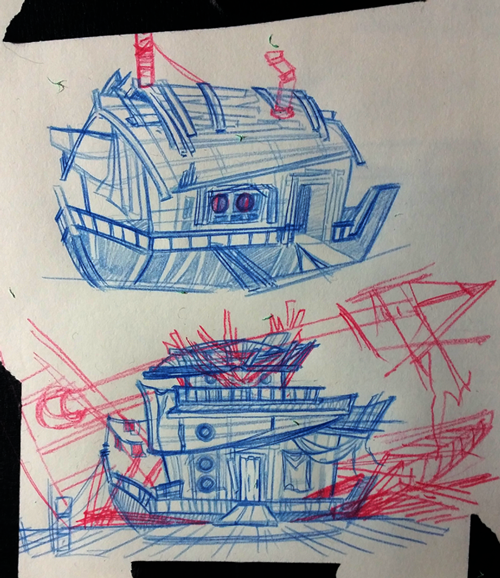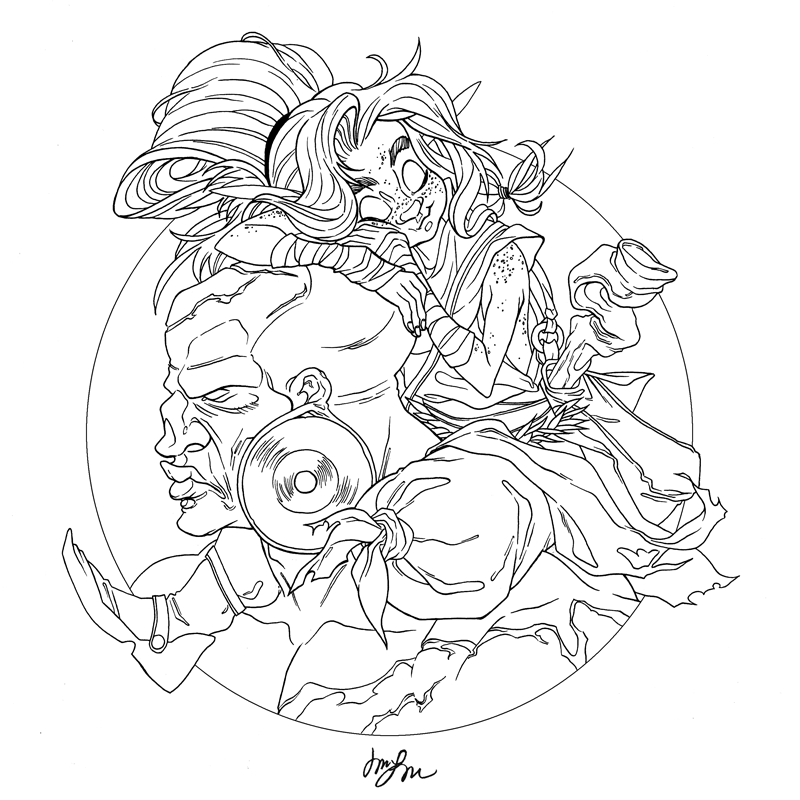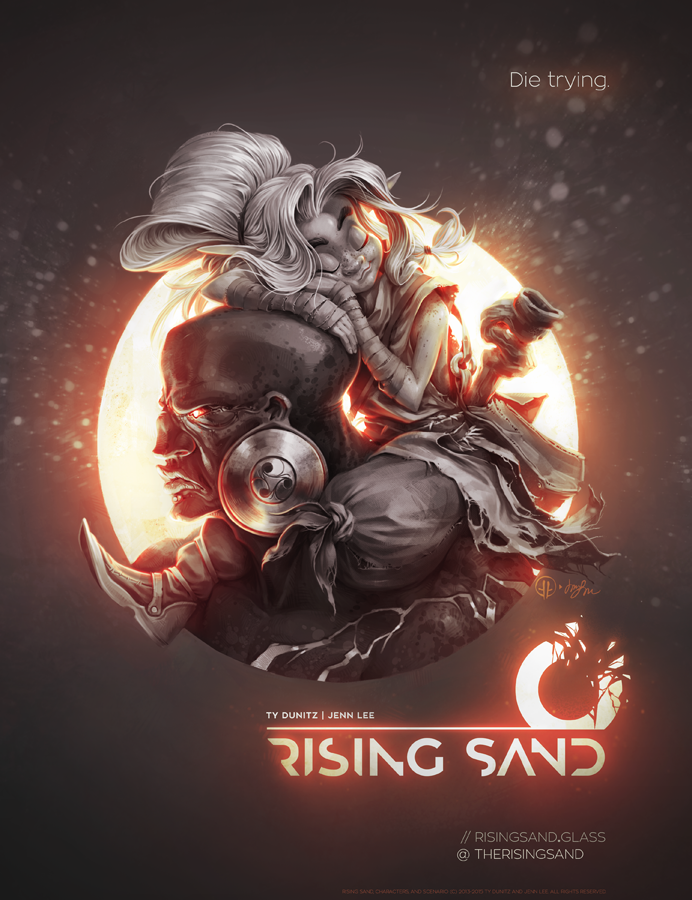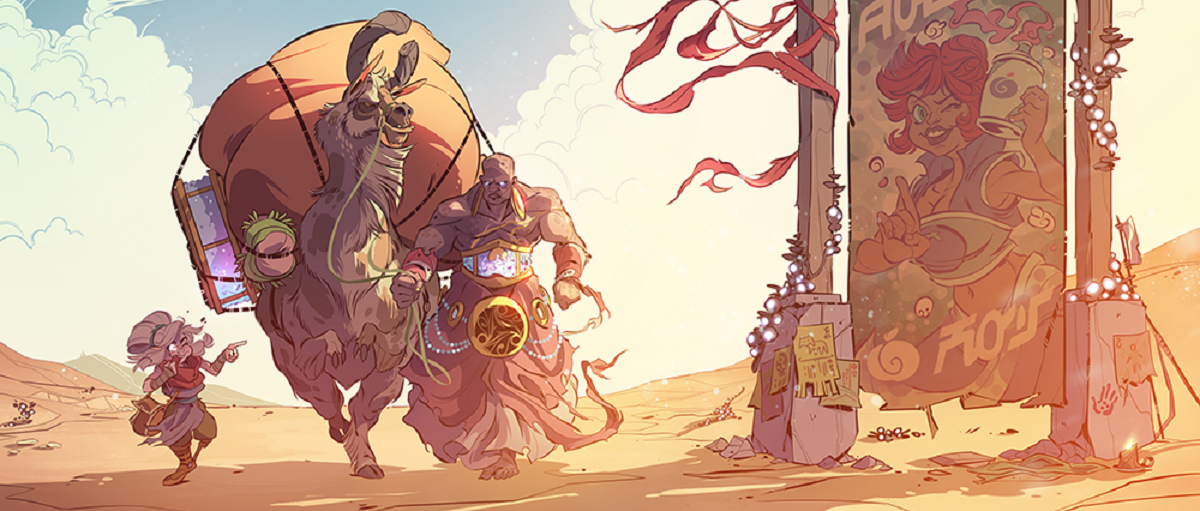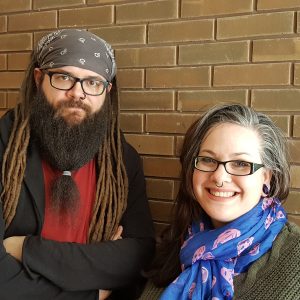Each week, Alex Lu is highlighting the work of some of the coolest illustrators of our generation. Know anyone who should be featured (including yourself)? Email [email protected].
This Week: Ty Dunitz and Jenn Lee are building an odyssey. When I first saw their webcomic, Rising Sand, my first thought was that this book mixes the haunting visual language that informs Boaz Lavie’s, Asaf Hanuka’s, and Tomer Hanuka’s graphic novel The Divine with the searingly warm color palette of Mad Max: Fury Road. And my next was:
How the fuck has Rising Sand not been picked up for publication yet?!
Dunitz and Lee are both fantastic artists in their own rights, but together they tell a story unlike any other out there. One that explores the rituals of religion, the consequences of duty, the search for family, and the tensions of sisterhood.
Welcome to Rising Sand.
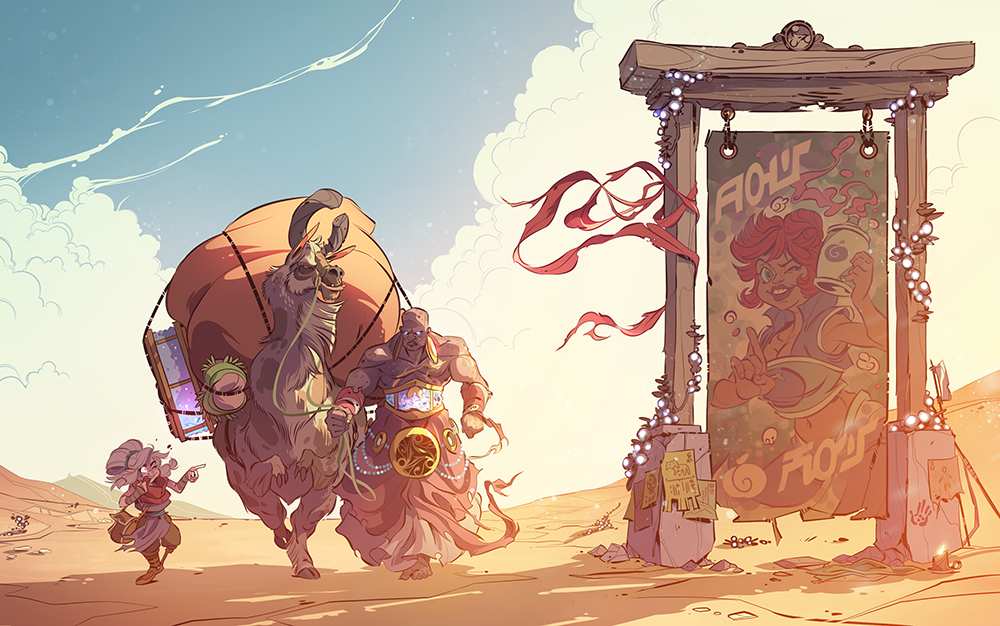
 Ty Dunitz & Jenn Lee
Ty Dunitz & Jenn Lee
Rising Sand | Ty’s Twitter | Jenn’s Twitter
Alex Lu: Ty, Jenn, you’ve been working on Rising Sand for a number of years now, but take us back to the beginning. What were your respective artistic backgrounds and how did you end up coming to work on this webcomic together?
Jenn Lee: My whole life plan was to graduate art school, nail down an animation job at Disney, and spend weekends in the dirt digging up dinosaurs. No, for real. That dream is actually written in a yearbook somewhere. Haven’t dug up any dinosaurs yet, but I did graduate art school. After that two years it was pretty clear animation was not my future. I felt kind of artistically aimless for a few years until I threw myself into comics. That was 11 years ago. I haven’t stopped since. About three years ago, Ty started showing me sketches of characters before it was RS. I fell in love with Dal and Qebrus as more of their story was revealed and basically spammed the hell out of Ty every morning with fanart doodles I did during spare minutes in my workday or while I was at the laundromat. He eventually gave in and was like “FINE. Let’s make a comic!”
Ty Dunitz: I’ve been a professional illustrator for nine years, most of it album covers and character art for games. I liked comics, but really had no interest in making one. Now it’s my primary project. I’m the Rising Sand guy. And it’s her fault.
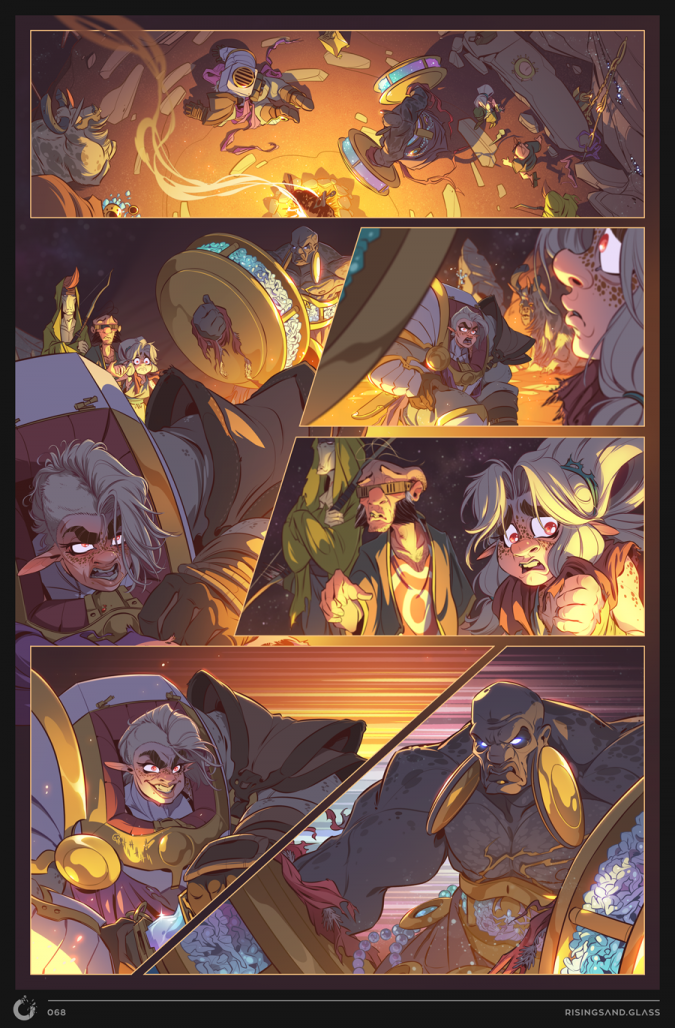
Jenn, after you got your hands on Dal’s and Qeb’s designs, how much did they change, if at all, before the main series started? Who’s been your favorite character in the series to draw, more generally?
Lee: Qeb’s original design was way more stony golem than the stoic beefcake he is now. He was basically my crash course in muscles and zero-expression. I had to relearn a lot of things and unlearn some bad habits. And in trying to figure him out, he lost some of his harder edges and longer shapes over time.
Dal’s current symmetrical “Disney bangs” is probably the biggest difference! Her hair was originally two shapes that shifted to whatever was most pleasing as her head turned, not really taking three dimensions into consideration. Think Goku’s hair! My determination to keep her hair more under “real world” rules essentially changed her design and Ty’s vision. We’re actually working on her Act 2 design to try to bring it closer to her original look. It’s already way better and more distinctive! I really can’t wait to get to her in the next act.
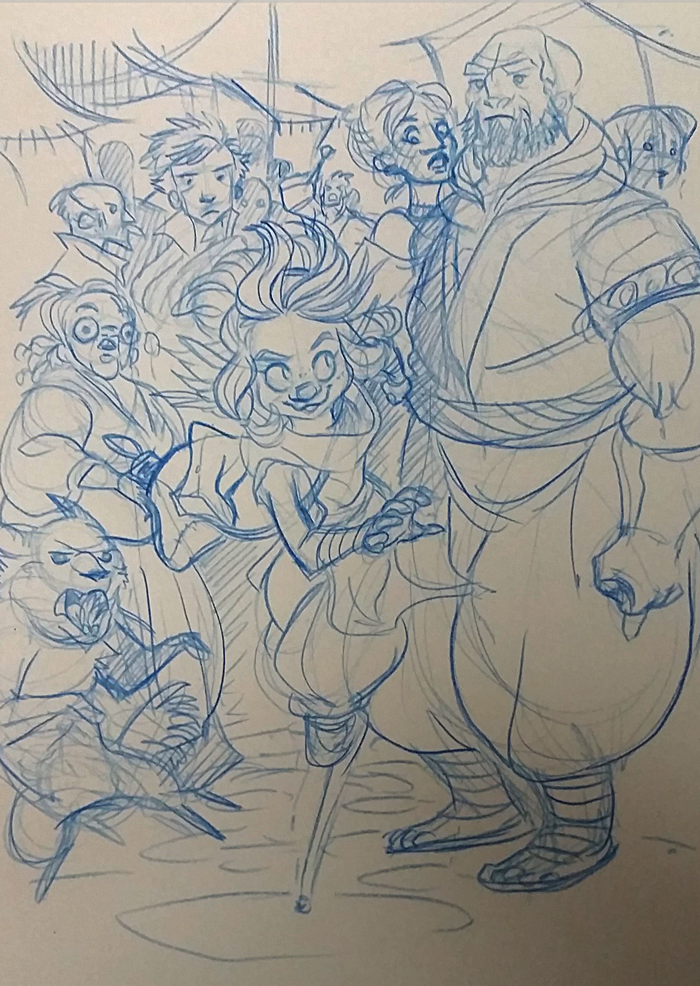
Gosh, how do you pick a favorite? I suppose, if I HAVE to choose, I think Sorril is my favorite. Even after the enormous difficulty I had with his shapes at first. He’s so lumpy and knobby and weirdly proportioned and just kinda GROSS that I can’t help but have so much fun whenever he’s on the page. I might be singing a different tune once Dal is smiling again. I miss that girl’s smile.
Lu: Right off the bat, it’s clear that Rising Sand is an incredibly fleshed out project. What you’ve built here is incredible, from the different species that inhabit the world to their various religions. Ty, I read in an earlier interview that the world of Rising Sand was based off an RPG world you were building. Is that right? How long did it take you to craft and what changed, if anything, as Jenn came on board?
Dunitz: The original idea was for a tabletop roleplaying game, yeah; the earliest material I have is from about 2009. And I haven’t abandoned that ambition! The focus has merely shifted indefinitely from game to comic. Before Jenn came aboard, I had several years of pure, out-of-control lorecrafting junking up my Google Docs—control I had to regain if I was going to successfully tell a comic-sized, linear narrative. Writing bottom-up, character-focused stories is still something I’m relatively new at, and one of the quickest lessons I’ve learned is that all the fine lore details in the world aren’t worth a damn if the story on the page isn’t making sense. I have to select only the most important bits of worldbuilding to commit to the page, and trust the audience has imagination enough to work out the rest.
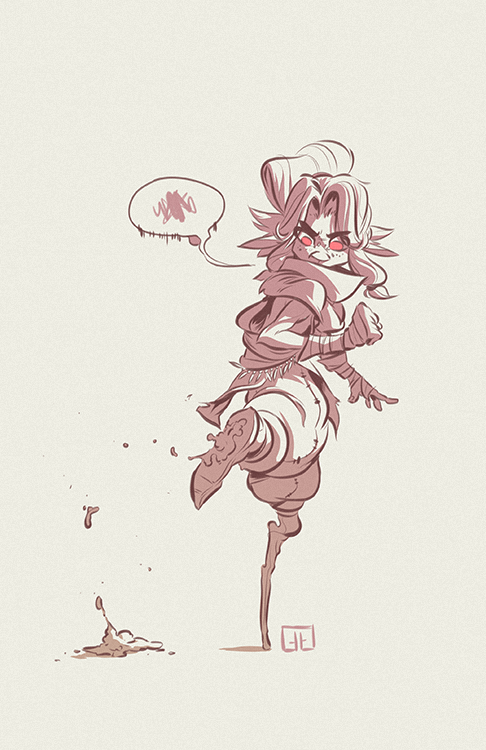
… I do cheat a little with those blurbs under each page. But I make sure those remain optional reading.
Lu: Speaking of bottom-up character-focused storytelling, the dynamic between Dal and her sister Ro is very moving and more than a little tragic. Was it always your intent to develop these characters in such extreme opposition to one another in terms of personality?
Dunitz: In perhaps the very first early proto-outline of the story, Dal was a bit older and Ro didn’t exist, but the story has been about the two of them as long as I care to remember. Should it turn out that I’m not a hack, one of the strongest themes in RS will remain family—the ones we’re given and the ones we choose, and the things that hold them together, or break them apart. In the case of Dal and Ro, this thing is faith (or the lack thereof), and neither is willing or able to see the other’s point of view. I don’t want to give anything away, but there is a specific moment at the top of act 2 that should lay bare for the reader the specific nature of the sisters’ rift—and, hopefully, make Ro a much more three-dimensional and relatable character than the ‘just kind of an ass’ we’ve seen thus far.
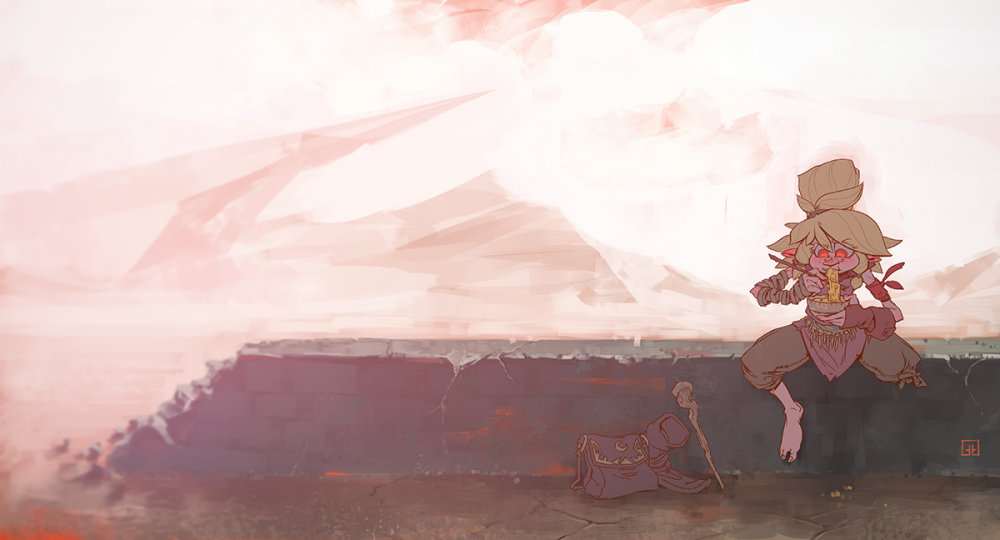
Lu: A particularly interesting facet of the worldbuilding to me is the Luminous Body, which Qeb believes in. How did you develop the idea for an actively avaricious religion?
Dunitz: Very little in Rising Sand is devised as a conscious reflection of something that already exists—I’m never aiming for commentary. I just want to tell a fun adventure story! However, to say that my own perspective isn’t baked into my work’s DNA would be a lie. I’m not about to pretend my story about the sun threatening to literally burn a world alive has nothing to do with my own anxiety about climate change. I may not have considered it when I built the scenario, but of course it’s there. As for the Luminous Body… from the looks of some American megachurches, I’d suspect it’s probably nothing we don’t already have IRL.
I also really like Star Trek, so there’s probably some Ferengi there, too.
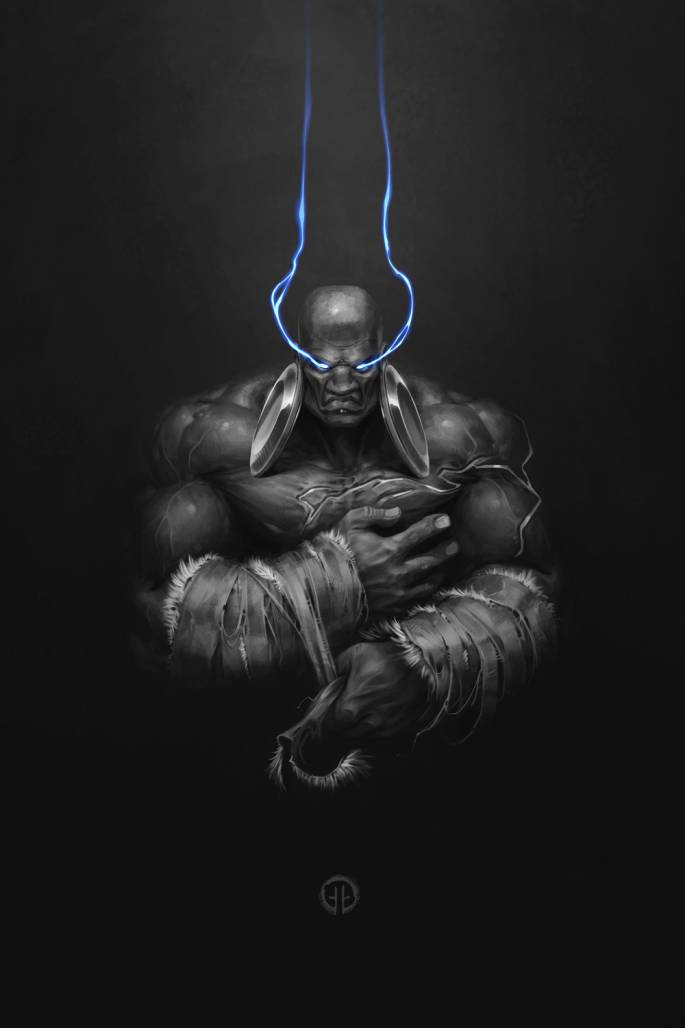
Lu: With a book this gorgeous and layered, there’s a lot that must go into this from concept to finished page. Take us through how you build each page from script to layouts to colors and letters. How do you divide your artistic duties?
Dunitz: To put it politely, I could definitely clean up my scripting process, which is equal parts unsent draft tweets, Google Keep notes Ctrl+V’d into Discord, and snapping my fingers while dictating half-remembered dialog I thought of while falling asleep the previous night. Luckily, being myself an illustrator, I can mitigate much of Jenn’s confusion by providing detailed thumbnails that explain how it all goes together. With apologies to her, though, she’s often largely in the dark about the panel-to-panel.
Lee: He apologizes, but I actually dig that we often think on our toes! That spontaneity makes it all the more exciting for me. I’ve worked under the rigidity of completely plotted out detailed as all hell panel-by-panel scripts before and I’m not sure it’s for me. I like having a rough idea of what’s expected for a page and then seeing it come together in Ty’s thumbnail. If I need anything more than that it’s usually an explanation of an shot angle or how Ro’s dang templar suit works in a particular perspective.
Up until page 049 I was all traditional, using scraps of tissue paper as the “layers” of roughs before lightboxing clean lines onto the actual board. There’s a few of the original traditional pages that are just wads of tape holding together roughs we thought didn’t need a final pass- like the “soup page” in the flashback. Now those layers are in Clip Studio Paint, but my process is basically the same. Red lines are rough, blue lines are clean! I then hand over the PSD to Ty for inks and color.
Dunitz: And then I do said inks and colour—which is about a 50/50 split between Photoshop and checking Twitter. Letters are letters. We’re STILL trying to work out the juggling multiple languages thing invisibly-yet-clearly.
Lu: Holy crap, Jenn. You were doing all of this on separate physical layers at the start?! How were you keeping track of it all? And when you switched to digital, did you find any difficulty in maintaining a similar linework style to your physical pencils?
Lee: I had only ever penciled traditionally before! It was truly all I knew. I dabbled a tiny bit in digital comic work (mostly coloring and sometimes inking), but I just never really latched onto it. It was honestly never a huge issue to keep track of everything. I kind of had a mini-production line going. Scribble roughs on scraps, tape them down, trace them over for final pencils, and move them to the side. Once the page was finished and scanned for Ty to ink, we’d put the board away in a portfolio and stuff the scraps behind it.

It was really hard for me to fully move to digital at first. I felt so lost. I didn’t feel like me and the stylus was really alien. I was determined to make it work this time though. No crawling back to my drawing table. Both Ty and I thought it would ultimately be beneficial for me to learn a new tool- one that could potentially cut time off of the penciling process and save us a bit of money on shipping. Once we loaded up Photoshop (and later CSP) with better brushes I was able to kind of trick my brain into seeing the lines as more traditional strokes, which then helped me get over the disconnect of working on a tablet and looking up at a monitor.
I really really enjoy working on a computer now! And it’s been helpful in loosening up my traditional work when I do it. Still slower than I’d like, but we’ve got some plans to combat that in both our roles in Act 2.
Lu: I want to focus on colors specifically for a moment now. One of the most striking things about Rising Sand, in my eyes, is that way that the color palette makes a world on the brink of apocalypse haunting and soothing to look at. How did you go about defining this soft tone for the world in contrast against the implicitly massive stakes of the story?
Dunitz: I wanted Rising Sand to engender desolation and vastness, not just in its vistas, but in its tone. Erj is a purgatory in which most everyone is just going about their business, waiting for the end. It’s hot, and still, and looking out onto the horizon, there is literally and metaphorically nothing ahead but the silence of death. Despite its animated art style and peppy dialog, RS is ultimately a dismal story—and one in which that hot, still atmosphere very much plays a role. The heavy reflected light and sunbleached assortment of pinks and oranges are to communicate the asphyxiating environment, like falling asleep and never waking up.
I also really just f**king hate blue.
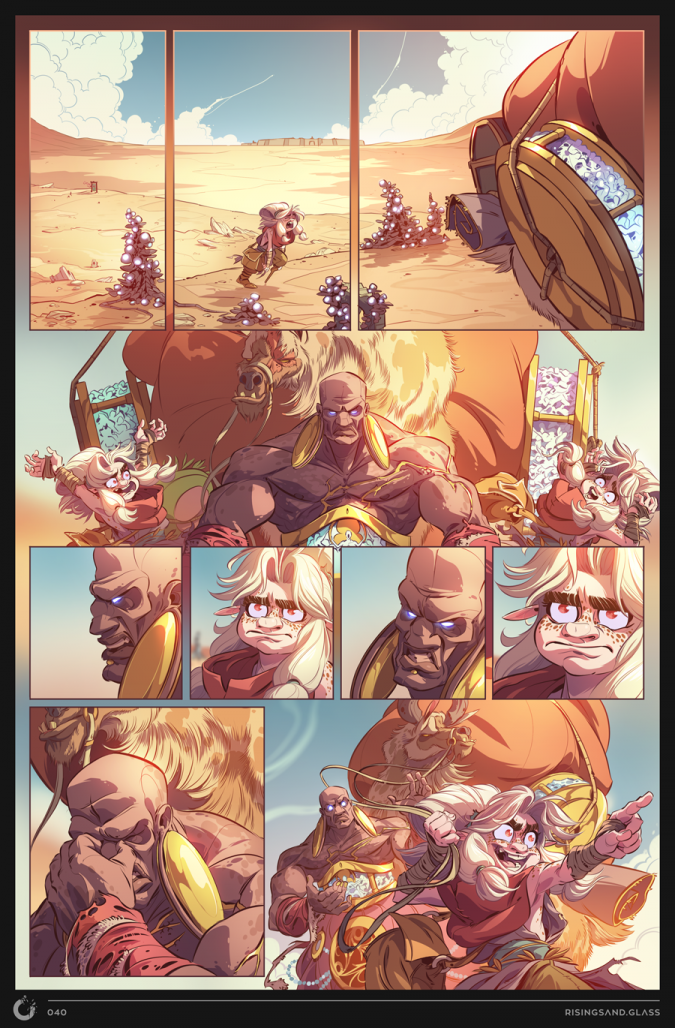
Lu: Given this sense of inevitability then, as the story of Rising Sand pushes forward, should we expect things things to get more overtly dour? Based on where we are now, it’s pretty clear that Qeb and Dal are going to have to have a difficult conversation about Ro very soon….
I forgive you for your hateful opinion on what is objectively the best color, by the way.
Dunitz: Some people’s kids.
To your question, I’d like to say yes, but given RS‘ colourful, animated presentation, I suspect we’ll be surprising readers with just how dire it gets all the way to the end. And that’s not to say it will lose its sense of fun, either! Rising Sand is about running out the clock, but it’s also about deciding what to do while you wait.
Lu: What are you long term plans for Rising Sand more generally? Do you see the story going on for some time? Do you hope to someday collect the story physically?
Dunitz: Someday, indeed—Kickstarter for volume one is later this very spring! Stay tuned to our Twitter for more on that.
As for the long run, I have no desire to stretch this out—for my benefit, and for the reader’s. Rising Sand is a specific story with a specific ending, and it’s thematically pointless if that ending is not achieved. Webcomics are usually a labour of love and are thus famous for f**king off mid-sentence, leaving scores of disappointed readers in their wake. I don’t blame anyone for not taking the format terribly seriously. But our patrons aren’t paying for my flight of fancy—this is a job as much as a love, and one I don’t want to still be working on at 40. Sundown or bust.
Lee: I am SO pumped for our physical copy Kickstarter! It’ll be our first one, so I’m personally a little terrified. But I like little to-do lists and there’s so many amazing creators out there that are happy to share what tactics have been successful (and even unsuccessful) with those eager to learn.
Like Ty said, we’re both in it to the end. We both love the story and the characters so much. We just don’t want it to become a decade-long project!
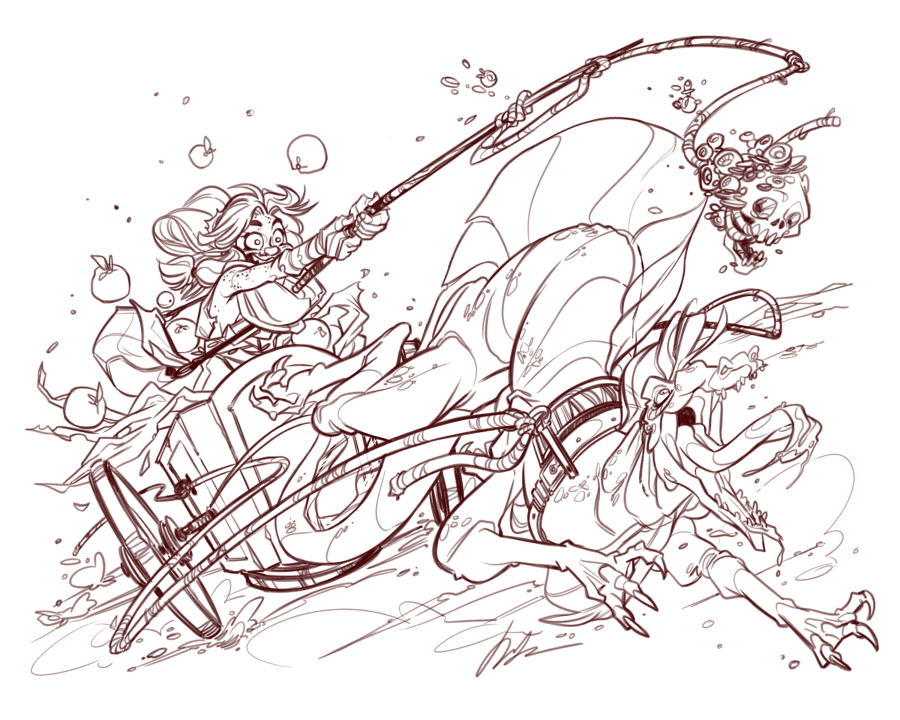
Lu: Outside of Rising Sand, are there any projects that you’re working on together or separately right now? What kinds of projects would you like to work on in the future?
Lee: We’re not working on anything together outside of RS at the moment! It’s such a big project so it takes up almost all of our time. I have managed to do a 10-page short for volume 2 of Sh*t Flingers, which will be kickstarted later this year! As for the future, I would really like to just continue working on my own properties. I have an eye-rollingly fluffy fantasy book that I would LOVE to finally finish. I’ve always been intimidated to try to translate it to comic form. It might be time to figure that out once RS wraps up!
Dunitz: I still take on the occasional freelance gig, but right now I’m lucky enough to have the time and freedom to give Rising Sand the attention I feel it deserves. Who knows how long that will last. I’m right where I want to be.
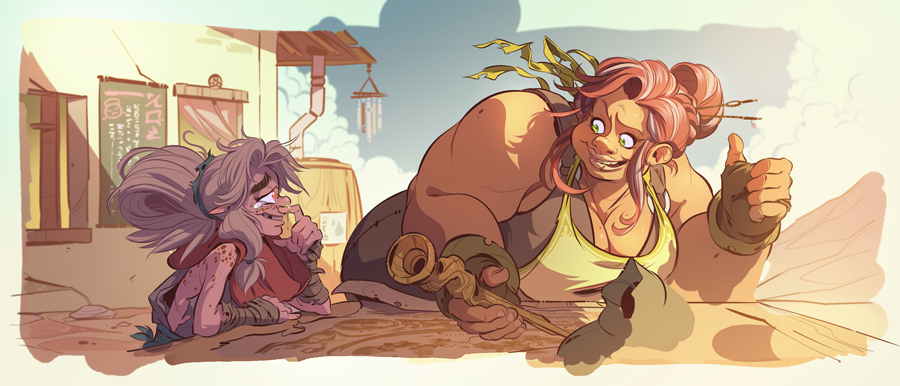
Additional Samples
